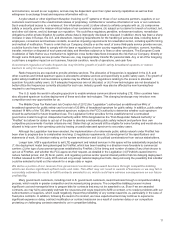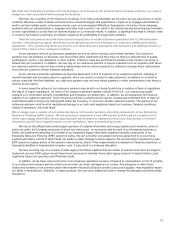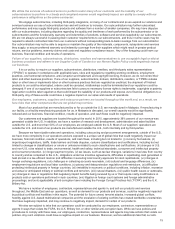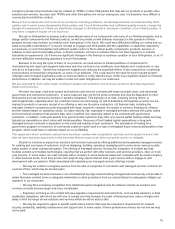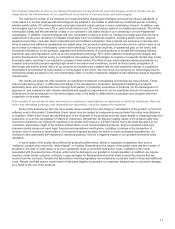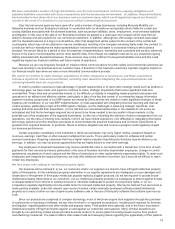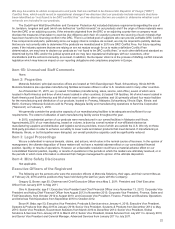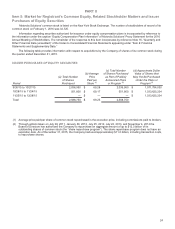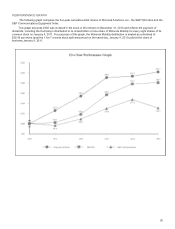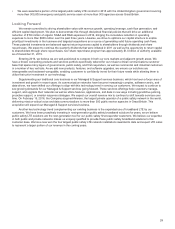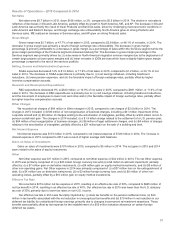Motorola 2015 Annual Report Download - page 22
Download and view the complete annual report
Please find page 22 of the 2015 Motorola annual report below. You can navigate through the pages in the report by either clicking on the pages listed below, or by using the keyword search tool below to find specific information within the annual report.21
Returns on pension and retirement plan assets and interest rate changes could affect our earnings and cash flows in
future periods.
Although we engaged in pension de-risking activities in 2014, we continue to have large underfunded pension obligations,
in part resulting from the fact that we retained almost all of the U.S. pension liabilities and a major portion of our non-U.S.
pension liabilities following our divestitures, including the distribution of Motorola Mobility, the sale of our Networks business and
the sale of our Enterprise business. The funding position of our pension plans is affected by the performance of the financial
markets, particularly the equity and debt markets, and the interest rates used to calculate our pension obligations for funding and
expense purposes. Minimum annual pension contributions are determined by government regulations and calculated based
upon our pension funding status, interest rates, and other factors. If the financial markets perform poorly, we have been and
could be required to make additional large contributions. The equity and debt markets can be volatile, and therefore our estimate
of future contribution requirements can change dramatically in relatively short periods of time. Similarly, changes in interest rates
can affect our contribution requirements. In volatile capital market environments, the uncertainty of material changes in future
minimum required contributions increases.
Changes in our operations or sales outside the U.S. markets could result in lost benefits in impacted countries and
increase our cost of doing business.
We have entered into various agreements with non-U.S. governments, agencies or similar organizations under which we
receive certain benefits relating to its operations and/or sales in the jurisdiction. If our circumstances change, and operations or
sales are not at levels originally anticipated, we may be at risk of having to reimburse benefits already granted, and losing some
or all of these benefits and increasing our cost of doing business.
We transferred a significant portfolio of intellectual property rights, including patents, to Motorola Mobility and Zebra
and we are unable to leverage these intellectual property rights as we did prior to the distribution of Motorola Mobility
or the sale of our Enterprise business.
We contributed approximately 17,200 granted patents and approximately 8,000 pending patent applications worldwide to
Motorola Mobility in connection with the distribution. We also transferred approximately 2,700 granted patents and approximately
800 pending patent applications to Zebra in connection with the sale of the Enterprise business. Although we have a worldwide,
perpetual, royalty-free license to these patents and other intellectual property rights, we no longer own them. As a result we are
unable to leverage these intellectual property rights for purposes of generating licensing revenue or entering into favorable
licensing arrangements with third-parties. As a result we may incur increased license fees or litigation costs. Although we cannot
predict the extent of such unanticipated costs, it is possible such costs could negatively impact our financial results.
We are subject to a wide range of product regulatory and safety, consumer, worker safety and environmental laws that
continue to expand and could impact our ability to grow our business, could subject us to unexpected costs and
liabilities and could impact our financial performance.
Our operations and the products we manufacture and/or sell are subject to a wide range of product regulatory and safety,
consumer, worker safety and environmental laws. Compliance with such existing or future laws could subject us to future costs
or liabilities, impact our production capabilities, constrict our ability to sell, expand or acquire facilities, restrict what products and
services we can offer, and generally impact our financial performance. Some of these laws are environmental and relate to the
use, disposal, clean up of, and exposure to certain substances. For example, in the U.S., laws often require parties to fund
remedial studies or actions regardless of fault and often times in response to action or omissions that were legal at the time they
occurred. We continue to incur disposal costs and have ongoing remediation obligations. Changes to environmental laws or our
discovery of additional obligations under these laws could have a negative impact on our financial performance.
Laws focused on: (i) the energy efficiency of electronic products and accessories, (ii) recycling of both electronic products
and packaging, (iii) reducing or eliminating certain hazardous substances in electronic products, (iv) and the transportation of
batteries continue to expand significantly. Laws pertaining to accessibility features of electronic products, standardization of
connectors and power supplies, the transportation of lithium-ion batteries and other aspects of our products are also
proliferating. There are also demanding and rapidly changing laws around the globe related to issues such as product safety,
radio interference, radio frequency radiation exposure, medical related functionality, and consumer and social mandates
pertaining to use of wireless or electronic equipment. These laws, and changes to these laws, could have a substantial impact
on whether we can offer certain products, solutions and services, on product costs, and on what capabilities and characteristics
our products or services can or must include.
These laws could impact our products and negatively affect our ability to manufacture and sell products competitively. We
expect these trends to continue. In addition, we anticipate that we will see increased demand to meet voluntary criteria related to
reduction or elimination of certain constituents from products, increasing energy efficiency, and providing additional accessibility.


